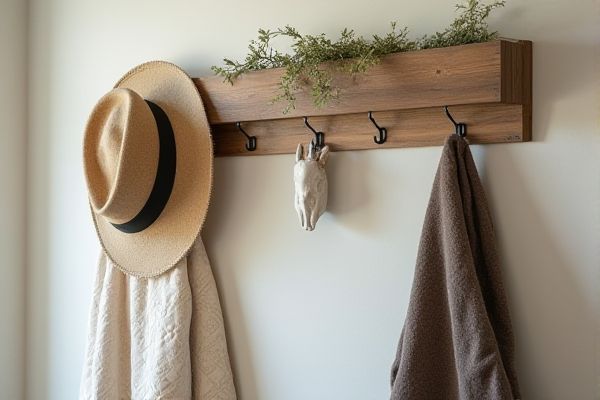
A hat rack offers a dedicated space for hanging and organizing hats, keeping them in shape and easily accessible, while an accessory tray serves as a catch-all for smaller items like keys, jewelry, and sunglasses, helping reduce clutter on surfaces. Discover how choosing the right option can optimize Your entryway or bedroom organization by reading the rest of the article.
Table of Comparison
| Feature | Hat Rack | Accessory Tray |
|---|---|---|
| Primary Use | Hanging and organizing hats | Storing small accessories like jewelry, keys, or coins |
| Design | Vertical stand or wall-mounted hooks | Flat surface, often shallow with subdivided compartments |
| Material | Wood, metal, or plastic | Wood, leather, metal, or plastic |
| Space Efficiency | Optimized for vertical storage | Compact, fits on tables or dressers |
| Portability | Less portable, usually fixed | Highly portable and easy to move |
| Capacity | Holds multiple hats at once | Holds various small items simultaneously |
| Ideal Location | Entryway, bedroom, or closet | Bedroom, dressing table, or office desk |
Introduction to Hat Racks and Accessory Trays
Hat racks provide a practical and stylish solution for organizing headwear, offering vertical storage that maximizes space and keeps hats easily accessible. Accessory trays serve as compact organizers designed to hold smaller items like keys, jewelry, and sunglasses, helping reduce clutter on surfaces such as entryway tables or dressers. Choosing between a hat rack and an accessory tray depends on your specific needs for either storing larger headwear or managing smaller personal items efficiently.
Key Differences Between Hat Racks and Accessory Trays
Hat racks primarily provide vertical storage for hats, coats, and scarves, maximizing wall space with hooks or pegs. Accessory trays offer a compact, horizontal surface designed to organize smaller items such as jewelry, keys, and watches, often placed on tabletops or dressers. The key difference lies in their functional design: hat racks optimize hanging storage for larger outerwear while accessory trays focus on corralling smaller personal belongings in a contained area.
Pros and Cons of Hat Racks
Hat racks offer a stylish and practical way to organize your headwear, freeing up space while keeping hats easily accessible and maintaining their shape. However, they can be limited in capacity and may create clutter if too many hats are hung, potentially causing imbalance or wall damage. Unlike accessory trays, which are compact for small items and keep surfaces tidy, hat racks prioritize display and accessibility for larger accessories like hats or scarves.
Pros and Cons of Accessory Trays
Accessory trays offer organized storage for small items like keys, coins, and jewelry, reducing clutter and ensuring easy access. They often feature compartments or sections to separate different objects, enhancing convenience and maintaining order. However, accessory trays may have limited space compared to hat racks and might not accommodate larger items, making them less versatile for diverse storage needs.
Space-Saving Solutions: Which is More Efficient?
A hat rack maximizes vertical space by organizing headwear and coats off the floor, making it ideal for small entryways or closets with limited floor area. An accessory tray, meanwhile, condenses smaller items like keys, wallets, and jewelry into a compact surface, reducing clutter on tables and countertops. Your choice depends on whether you need to efficiently store larger items or keep everyday essentials neatly accessible.
Style and Aesthetic Considerations
Hat racks often serve as functional statements with vertical designs that add height and visual interest to entryways, complementing traditional or rustic decor styles. Accessory trays, with their low-profile and versatile surfaces, integrate seamlessly into modern or minimalist interiors by organizing smaller items without overwhelming the space. Choosing between a hat rack and an accessory tray depends on your preferred aesthetic balance between vertical display and subtle organization.
Best Uses for Hat Racks in Home Organization
Hat racks excel at keeping your entryway tidy by providing a dedicated space for hats, scarves, and coats, preventing clutter from accumulating on furniture or floors. Unlike accessory trays, which are ideal for small items like keys or jewelry, hat racks offer vertical storage that maximizes wall space and enhances home organization. Your home benefits from the easy access and visibility hat racks provide, making it simple to grab and store outerwear as you come and go.
Optimal Uses for Accessory Trays
Accessory trays are ideal for organizing and displaying small items such as jewelry, keys, coins, and watches, making them perfect for entryways, dressers, or bedside tables. Unlike hat racks, which are designed primarily for hanging hats and coats, accessory trays maximize limited space by keeping personal belongings neatly contained and easily accessible. Your home benefits from the convenience and tidiness that accessory trays provide, especially in areas where clutter tends to accumulate.
Maintenance and Cleaning Tips
Hat racks require regular dusting with a soft cloth to maintain their appearance and prevent buildup in corners or crevices. Accessory trays benefit from frequent wiping with a damp cloth and mild detergent to remove dirt, oils, and residue from jewelry or small items. Both organizers should be dried thoroughly after cleaning to avoid moisture damage and ensure longevity.
Choosing the Right Option for Your Needs
Selecting between a hat rack and an accessory tray depends on your storage goals and available space. A hat rack offers vertical storage, ideal for hats and coats, maximizing wall space in entryways or closets. An accessory tray provides a compact solution for organizing smaller items like keys, watches, and jewelry, best suited for tabletops or dresser surfaces.
 homyna.com
homyna.com